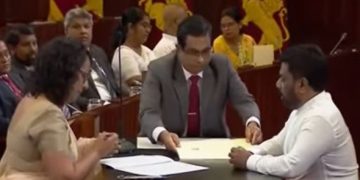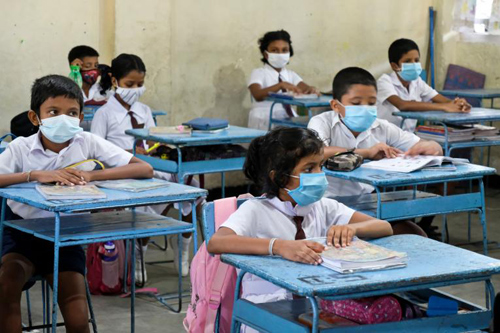By Sugeeswara Senadhitra/Daily News
Colombo, September 24: The world is faced with an unprecedented health crisis due to the COVID-19 pandemic and its effect on the economy is shocking. While economists are of the unanimous opinion that the world economy could be revived after absorbing the short-term shocks, the long-term concern is over the education crisis.
This generation of children and youth cannot anymore afford disruptions to their education, which is why experts have called upon governments to re-open schools as soon as possible and get education back on track.
For similar articles, join our Whatsapp group for the latest updates. – click here
However, segments of society including lawmakers, teachers and parents say that children should not be open to even the slightest health risk. So far, data suggests that children under the age of 18 represent about 8.5% of the reported COVID cases, with relatively few deaths compared to other age groups. The disease is generally mild in the case of children. In Sri Lanka, of the 12,376 fatalities due to COVID-19, the 5-18 age group accounts for a mere 0.18 percent.
At the same time the role of children in the transmission of the virus is not yet fully understood because hardly any research has been conducted in this field. To date, very few outbreaks involving children or schools have been reported abroad. The small number of outbreaks reported among teaching or associated staff, to date, suggests that the spread of COVID-19 within educational settings may be limited.
On the other hand, school closures have clear negative impacts on child health, education and development, family income and the overall economy. According to global data, for nearly 77 million children, the pandemic has taken away their classrooms in the past 18 months. Schoolchildren worldwide have lost 1.8 trillion hours of in-person learning due to COVID-19 lockdowns.
Medical experts say the rapid expansion of programs for the vaccination of children is the only pragmatic answer. State Pharmaceuticals Corporation (SPC) Chairman Dr. Prasanna Gunasena said vaccination for children in the age group 12–19 will commence Friday September 24. He said vaccine stocks have been received for the vaccination of schoolchildren and another consignment is scheduled to arrive next month.
READ: Unproven herbal medications haunt Sri Lanka’s vaccination drive
Briefing the media at the Presidential Media Centre (PMC) on Thursday, Dr. Gunasena said President Gotabaya Rajapaksa, at the last discussion with health experts at the Presidential Secretariat, has granted authority to the Ministry of Health to take the necessary technical decisions stating that if the Health Ministry grants the approval, vaccines can be administered to children without any hindrance.
The SPC Chairman stated that Sri Lanka will receive around four million doses of the Pfizer vaccine by October. The vaccination program for the 12–19 age group will be later extended to cover the entire island.
GMOA’s Dr. Anuruddha Padeniya, emphasizing the need for reopening schools, pointed out that UNICEF has declared that “schools should be the last to close and first to open.” He said that the vaccination program for selected children in the age group 12 to 19 suffering from chronic diseases such as cerebral palsy, epilepsy, diabetics, thalassemia and Down Syndrome will begin on Friday at the Lady Ridgway Hospital.
Prof. Pujitha Wickremasinghe said the right to go to school and learn is central to every child’s development, safety and well-being. Yet, in too many countries, classrooms remain closed while social gatherings continue to take place in restaurants, salons and gyms.
Earlier, the GMOA had said that the COVID-19 virus is spreading rapidly among children, with around 180 children confirmed to have contracted the virus, across the country.
While Dr. Padeniya noted that teachers and non-academic staff have already been vaccinated, other specialists stressed the importance of children’s education. Children should be allowed to complete their studies and continue to the next level. There is a need to restore the essential services, access to nutrition and child welfare measures such as prevention of violence against children, social and psychological well-being, extra-curricular activities and play, and access to reliable information. They should be told how to keep themselves and others safe from the infection.
While re-opening schools, there are several actions and requirements that should be reviewed and put in place. Special provisions should be considered for early childhood development, higher learning institutions, residential schools or specialized institutions, the specialists said.
WHO has recommended that steps should be taken to carry out early detection, testing, contact tracing and quarantine of contacts; investigation of clusters; ensuring physical distancing, hand and hygiene practices and age-appropriate mask use. Vulnerable groups should be shielded.
Community-led initiatives such as addressing misleading rumors play an important role in reducing the risk of infection. Academic and non-academic staff in schools have a major responsibility in maintaining hygiene and daily practices at the school and classroom level. They include physical distancing of at least one meter between individuals including by spacing of desks, frequent hand and respiratory hygiene, age-appropriate mask use, and ensuring that ventilation and environmental cleaning measures are put in place to limit exposure.
Schools should educate staff and students on COVID-19 prevention measures, develop a schedule for daily cleaning and disinfection of the school environment, facilities and frequently touched surfaces, and ensure availability of hand hygiene facilities and national/local guidance on the use of masks.
Dr. Gunasena said as children generally have milder illness and fewer symptoms, cases may sometimes go unnoticed. Importantly, early data from studies suggest that infection rates among teenagers may be higher than in younger children.
Considering that many countries are starting to slowly lift restrictions on activities, the longer-term effects of keeping schools open on community transmission are yet to be evaluated. Some modelling studies suggest that school re-opening might have a small effect on wider transmission in the community. Further studies are underway on the role of children in transmission in and outside of educational settings.
Dr. Padeniya said that research by the WHO and UNICEF have verified that restaurants and markets could spread diseases faster than schools.
Deciding to close, partially close or re-open schools should be guided by a risk-based approach, to maximize the educational well-being and health benefit for students, teachers, staff, and the wider community, and help prevent a new outbreak of COVID-19 in the community.
Children in the UK aged 12 to 15 are set to be able to get a COVID-19 jab, following advice from the UK’s chief medical officers. They have recommended that the youngsters should be offered one dose of the Pfizer vaccine. In May, the European Medicines Agency (EMA) approved the Pfizer vaccine for 12 to 15-year-olds. Since then, different EU countries have moved at different speeds.
Denmark (12 to 15-year-olds) and Spain (12 to 19-year-olds) have both now vaccinated most of their child population with at least a single dose. France too has been moving quickly with 66 percent of those aged 12 to 17 now single jabbed, and 52 percent fully vaccinated. By October the country’s Health Pass – or Pass Sanitaire – will be extended to under-18s, meaning all teenagers will need to show proof of vaccination or a negative COVID-19 test to access places like cinemas, museums, restaurants and indoor shopping centers.
In June, Germany’s scientific advisers recommended that the vaccine should only be offered to children aged 12 to 15 with underlying health conditions. But in August, after the Delta Variant started spreading more widely, the rollout was extended to all those over 12.
In Sweden, children aged 12 to 15 only are eligible for a jab if they have lung disease, severe asthma or another high-risk medical condition. In Norway, not part of EU, the vaccine jab was recently extended to children aged 12 to 15, but only a first dose will be offered, with a decision on a second dose to be made later.
In May, United States and Canadian regulators were the first to approve the Pfizer jab for use in children from 12 years and older. The rollout started immediately at sites across the US with two injections given three weeks apart.
Sri Lanka is one of the first developing countries to commence a vaccination program for schoolchildren. Dr. Gunasena said that all the safety measures have been taken and the vaccination program is conducted in hospitals under the presence of child specialists, with the prior consent of parents and approval of a specialist doctor.
END
Subscribe to our Whatsapp channel for the latest updates from around the world
































































